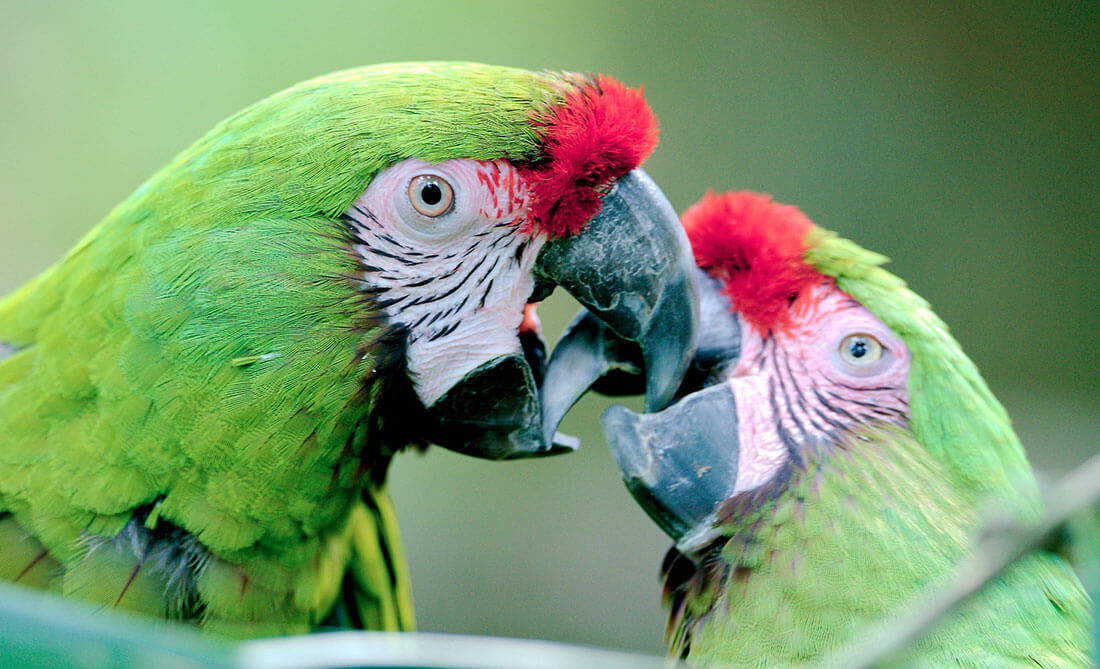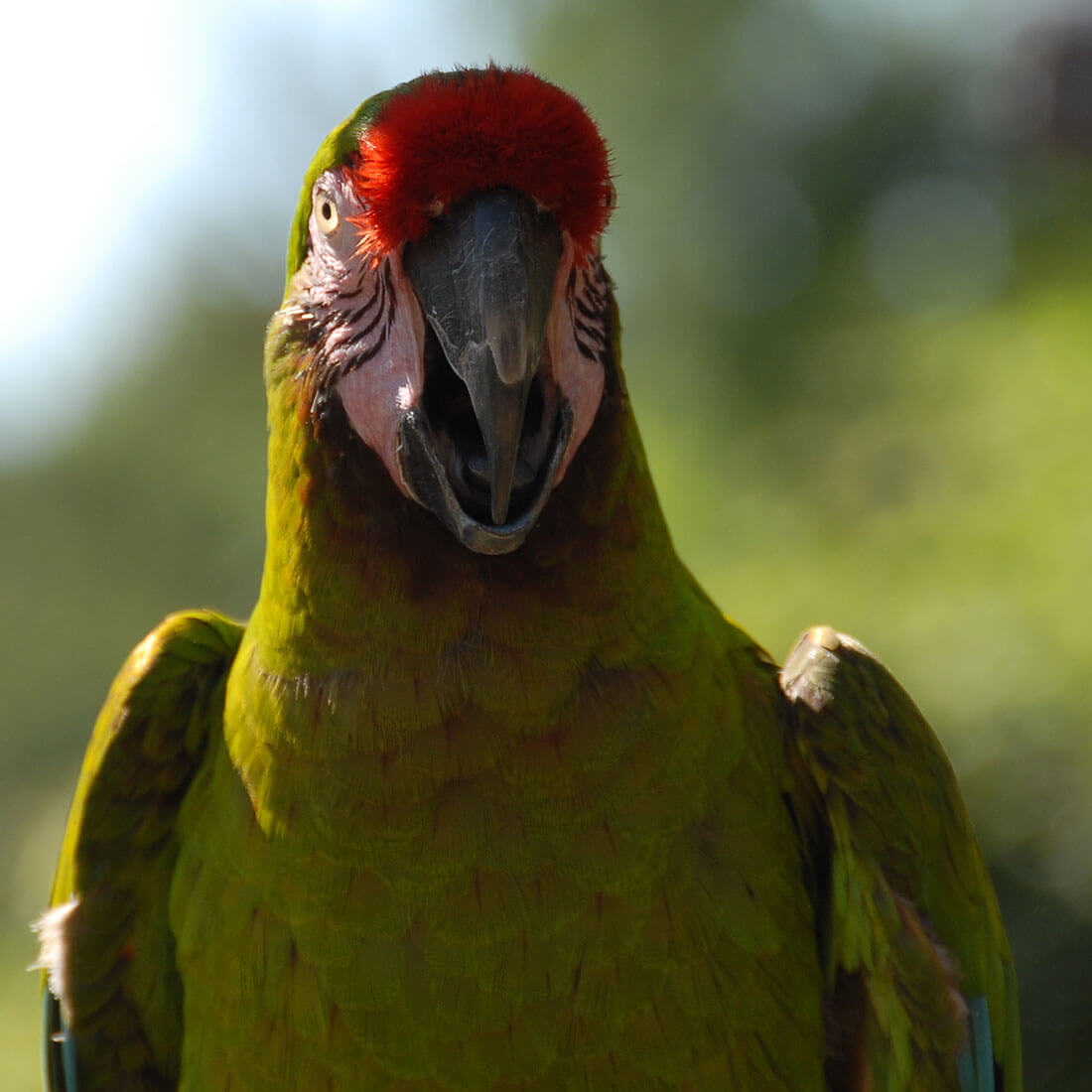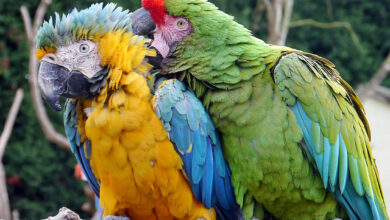Military Macaw ( Ara Militaris )
Military macaw is so-called because they were first brought to Europe by military personnel. It suggests that the name comes from the colour of their plumage, being “army” or olive green. Military macaws are native to Central and South America and their range generally extend from Mexico to Argentina.
Uniquely, military macaws prefer to live in arid lands and they can be found in open-dry forests and treelines near water. However, some of them can be found in the humid lowland forests as well as canyons and foothills. In short, military macaws are beautiful and different from other breeds of macaws.

Quick information on Military Macaws
- Also known as Guacamayo Verde (Spanish), Guacamayo Militar (Spanish)
- Their size is 27.8 in (70.5 cm) length with a wingspan of 33-43 in (99-110 cm)
- Scientific name: Ara militaris
- Population: 6,000 to 15,000 adults
- Trend: Decreasing
- Kingdom: Animalia
- Phylum: Chordata
- Class: Aves
- Genus: Ara
- Tribe: Arini
- Subfamily: Ariane
Status
The military macaw is an endangered species. Though the overall population exceeds 10,000, habitat loss and trapping for the pet trade has placed some regional populations in the endangered category. Without the protections established for the entire species, the decline could become even more rapid which has been decreasing over the past fifty years.
Now military macaws are listed as Vulnerable on IUCN Red List Category and are also safe as they are listed in CITES (Convention on International Trade in Endangered Species of Wild Fauna and Flora); prevents the birds from being captured for trade.
Threats and conservation
As the IUCN reports that the Military Macaw is vulnerable, and there is some lack of clarity on the overall population of this species so according to the estimates made in 2016, they range from the lowest 1,000 breeding pairs to the highest 10,000 individual birds.
There are two main threats to the species. Firstly, it traps at high levels for the pet trade as well as being affected by habitat loss. Where the macaw’s nest in tree cavities, these nests are very vulnerable to poaching. It was estimated in 2002, 23% of suitable habitat in Mexico had been lost. Secondly, military macaws persecute as a pest in these areas, as it uses agricultural land.
Diet
Their diet consists of seeds, fruits, nuts, berries, flowers, leaves, figs, nectar and other vegetation found on treetops in the rainforests. Coupled with this, their beaks well adapts for eating various seeds and nuts as they have the ability to break the hardest of shells with ease.
Military macaws also visit clay heaps known as ‘macaw licks’ which are found along riverbanks as macaws feed on these clay deposits. Moreover, which help to detoxify the poisons found in the seeds and vegetation of their diet. Their diet differs from other parrots as they need more fat in their diet. Comparatively, the diet of wild macaw tends to be high in fat, which is acceptable for a bird that spends its day flying through the rainforest, finding food, nesting, and rearing chicks.
Characteristics
The head of military macaw has slightly paler shade with all green body. They have a red patch on the front, with a white bare facial area secured with narrow black lines.
Similarly, their flight feathers are blue and the red tail borders with blue. Their large strong beak is grey-black and the iris is yellow. Surprisingly, they can be heard even before they are seen as they are quite noisy. The Military Macaw measures 70-80 cm in length. Likewise, the military subspecies is the smallest and the Mexicana subspecies is the largest.
Reproduction
The three subspecies of military macaw breed at different times and mostly their breeding occurs from January to March. In like manner, the Mexicana species breeds from April to July and the Bolivian species breeds in November and December.
Military Macaws remain with their mates for life and the mates also fly together when they fly around in large flocks. On the other hand, females lay one or two eggs which she will incubate for approximately 26 days. They reach their sexual maturity in 2 to 4 years and can live around 50-60 years in the wild.
Temperament
Military Macaws are in general rather noisy birds! They make a lot of different sounds; sometimes shrieking, chirping, and sometimes making the signature ‘kraa-aak!’ sound. This feature of the bird also makes it an exceptionally delightful pet, as the bird tries to imitate the sounds it hears. Though, you can even train them to talk! Macaws are quite playful and inquisitive.
Behaviour
They are noisy birds, giving loud creaking calls and shrieking cries. They forage in pairs or groups of up to 10 individuals and feed largely on fruit and nuts. Nests built in cliff cavities or in tree holes, with the preference varying across different parts of the macaw’s range. They lay two or three eggs, and in Mexico, the breeding season falls in June.
Military Macaw as a Pet
Many people crave to keep Military Macaws as pets. It is a medium-sized bird, unlike other species of parrots. Hence Military Macaw needs more attention and care.
Related Pick: Macaw as a Pet: Everything You Need to Know!
Be sure you are well-informed before you pick a macaw as a pet, for they truly can turn out to be ‘friends for life’ as they love to interact with humans.

Green Macaw Care as a Pet
A tall cage is essential for a military macaw to prevent its tail and feathers from hitting the cage bottom, which can cause them to bend or break.
Health Problems
Some of the illnesses that can affect military macaw are:
- Psittacosis
- Proventricular Dilatation disease
- Bacterial, viral and fungal infections
- Juveniles may suffer from beak malformations
- Gout
- Heavy metal poisoning
- Older birds sometimes develop Lipoma
Price
Military macaws can cost you around $1,000.
Facts
- The military species is only medium-size.
- Their talking ability is moderate to impressive as reported by people who have kept them as pets.
- The beak of this bird forms part of a great adaptation because it has the ability to break open the hardest seeds.
Featured Image Courtesy by Flickr
